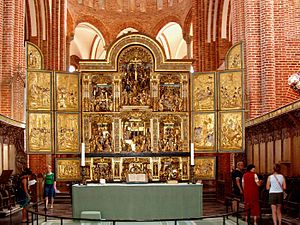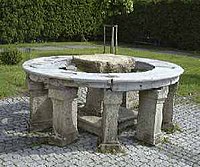පූජාසනය
මෙම ලිපිය පරිවර්තනය කළ යුතුය කරුණාකර මෙම ලිපිය සිංහල භාෂාවට පරිවර්තනය කිරීමෙන් දායකවන්න. |

පූජාසනයක් (ඉංග්රීසි:Altar) යනු ආගමික වාතාවත්, පූජාවන් හෝ වෙනත් චාරිත්රානුකූල අරමුණු සඳහා ඉදිරිපත් කිරීම සඳහා මේසයක් හෝ වේදිකාවකි. පූජනීය ස්ථාන, පන්සල්, පල්ලි සහ වෙනත් ආගමික ස්ථානවල පූජාසන දක්නට ලැබේ. ඒවා විශේෂයෙන් පේගන්, ක්රිස්තියානි ධර්මය, බුද්ධාගම, හින්දු ආගම, යුදෙව් ආගම[a], නූතන පේගන් සහ කොකේසියා සහ කුඩා ආසියාව අවට ඇතැම් ඉස්ලාමීය ප්රජාවන්හි භාවිතා වේ. බොහෝ ඓතිහාසික-මධ්යකාලීන ඇදහිලි වන රෝමානු, ග්රීක සහ නෝර්ස් ආගම් ඇතුළුව ඒවා භාවිතා කර ඇත.
පුරාණ කාලයේ පූජාසන
[සංස්කරණය]- පුරාණ කාලයේ පූජාසන
-
ඊශ්රායලයේ Tel Be'er Sheva හි උල් සහිත පූජාසනය.
-
ක්රි.පූ. 480 දී පමණ පූජාසනයක් පෙන්වන පුරාණ ග්රීක බීම කෝප්පය. Attalus හි Stoa හි ඇතන්ස්හි පුරාණ Agora කෞතුකාගාරය
-
බර්ලිනයේ පර්ගමන් කෞතුකාගාරයේ ප්රතිසංස්කරණය කරන ලද පර්ගමන්හි පුරාණ පූජාසනය.
-
ඔස්ට්රියාවේ පූජා පර්වතය. එය පුරාණ කෙල්ට්වරුන් විසින් පූජා කිරීම සඳහා භාවිතා කරන ලද අතර දැන් එය එහි බැසිලිකාවේ ප්ලාසා හි පිහිටා ඇත.
යුදෙව් ආගම
[සංස්කරණය]The first altar recorded in the Hebrew Bible is that erected by Noah.[1] Altars were erected by Abraham,[2] by Isaac,[3] by Jacob,[4] and by Moses.[5]
After the theophany on Mount Sinai, in the Tabernacle—and afterwards in the Temple—only two altars were used: The Altar of Burnt Offering, and the Altar of Incense, both near where the Ark of the Covenant was located.
ක්රිස්තියානි ධර්මය
[සංස්කරණය]-
Dedication of an altar
-
A home altar in a Methodist Christian household, with a cross and candles surrounded by other religious items
-
Early Coptic
බටහිර ක්රිස්තියානි පල්ලිවල
[සංස්කරණය]-
Altar of Santa Cecilia in Trastevere
-
Altar of Newman University Church, Dublin, with an altar ledge occupying the only space between it and the wall
කතෝලික සභාව
[සංස්කරණය]-
High altar of Saint Peter's Basilica, Rome
-
High altar of St. Michael's Church, Munich, dwarfed by a huge reredos
-
St. Valentine's Church the altar of Our Lady of Sorrows and Child in Osieczna, Poland
The liturgical norms state:
- It is fitting that the tradition of the Roman liturgy should be preserved of placing relics of martyrs or other saints beneath the altar. However, the following should be noted:
- (a) Relics intended for deposition should be large enough that they can be recognized as parts of human bodies. Hence excessively small relics of one or more saints must not be deposited.
- (b) The greatest care must be taken to determine whether relics intended for deposition are authentic. It is better for an altar to be dedicated without relics than to have relics of doubtful credibility placed beneath it.
- (c) A reliquary must not be placed on the altar, or in the table of the altar; it must be beneath the table of the altar, as the design of the altar may allow.[7]
රෙපරමාදු පල්ලි
[සංස්කරණය]-
An altar located in the middle of the pulpit, namely the Batak Christian Protestant Church, one of the Lutheran churches in Indonesia located in Tarutung, North Sumatra.
-
Contemporary altar at the Lutheran Bavnehøj Kirke[da].
-
The Lutheran altar in Bad Doberan Minster
ලූතරන් පල්ලි
[සංස්කරණය]-
Altar of Turku Cathedral
ඇංග්ලිකන් පල්ලි
[සංස්කරණය]-
The "low" altar area at Canterbury Cathedral[b]
-
The Lord's Table in St Barnabas' Church, Dulwich (Diocese of Southwark)
-
Altar in Bunyip, Victoria, Australia
-
Altar at Grace Cathedral, San Francisco
-
Altar at Anglo-Catholic Church of the Good Shepherd (Rosemont, Pennsylvania)
Eastern Christian Rites
[සංස්කරණය]Byzantine Rite
[සංස්කරණය]-
A traditional Russian Orthodox Holy Table (altar), Church of the Saviour on the Blood, St. Petersburg
-
The Holy Place (sanctuary) in the church of the Saint Vladimir Skete at Valaam Monastery.
-
A contemporary Byzantine Catholic altar during the Divine Liturgy at St. Joseph Church in Chicago, Illinois.
Syro-Maronite Church
[සංස්කරණය]The Syriac Maronite Church, along with the other Syriac Churches, has freestanding altars in most cases so the priests and deacons can circumambulate the altar during processions and incensations. Traditionally the Maronite liturgy was offered with the priest and people oriented to the East but because of modern latinizations it is common to find Maronite liturgies offered with the priest facing against the people from the opposite side of the altar, in imitation of modern practices in the Latin Church.
Oriental Rites
[සංස්කරණය]Armenian Rite
[සංස්කරණය]-
Altar at the Etchmiadzin Cathedral
Alexandrian Rite
[සංස්කරණය]Ethiopic Rite
[සංස්කරණය]West Syriac Rite
[සංස්කරණය]East Syriac
[සංස්කරණය]Indian Orthodox
[සංස්කරණය]War altar
[සංස්කරණය]හින්දු ආගම
[සංස්කරණය]-
Shree Ganesh Mandir, Jhansi
-
A family altar in India
තාඕවාදය
[සංස්කරණය]බුද්ධාගම
[සංස්කරණය]-
A bàn thờ (worship table) is an altar used in ancestral worship and worship of Buddhas and gods in Vietnam
-
A butsudan at ShinDo Buddhist Temple
ශින්ටො
[සංස්කරණය]-
A Shinto Kamidana (household altar) in Japan. Note the shimenawa, a rope demarking the sanctuary area seen above, along the ceiling.
නෝර්ස් පේගන්
[සංස්කරණය]Asatru
[සංස්කරණය]Neopaganism
[සංස්කරණය]Wicca
[සංස්කරණය]Neo-Druidism
[සංස්කරණය]උස් ස්ථාන
[සංස්කරණය]High places are elevated areas on which altars have been erected for worship in the belief that, as they were nearer heaven than the plains and valleys, they are more favourable places for prayer. High places were prevalent in almost all ancient cultures as centers of cultic worship.
High places in Israelite (Hebrew: Bamah, or Bama) or Canaanite culture were open-air shrines, usually erected on an elevated site. Prior to the conquest of Canaan by the Israelites in the 12th–11th century BCE, the high places served as shrines of the Canaanite fertility deities, the Baals (Lords) and the Asherot (Semitic goddesses). In addition to an altar, matzevot (stone pillars representing the presence of the divine) were erected.[8]
The practice of worship on these spots became frequent among the Hebrews, though after the temple was built it was forbidden. Such worship was with difficulty abolished, though denounced time after time by the prophets as an affront to God. A closely related example is a "backyard" altar, so to speak. Before there was a set temple and an established altar people built their own altars. After the temple was built use of these altars was forbidden. Unlike the case of high places, "backyard" altar worship was quickly eradicated. In following years, the practice drastically decreased in popularity.
පාද සටහන්
[සංස්කරණය]- ^ Altar use in Judaism is historical only: It ended with the destruction of the Second Temple.
- ^ The "high" altar is out of sight in the background, beneath the window. When the low altar is in use, the high altar in the back is not used, and stands "undressed".
යොමු කිරීම්
[සංස්කරණය]- ^ Genesis 8:20
- ^ Genesis 12:7, 13:4, 22:9
- ^ Genesis 26:25)
- ^ 33:20, 35:1–3
- ^ Exodus 17:15
- ^ උපුටාදැක්වීම් දෝෂය: අනීතික
<ref>ටැගය;GIRMනමැති ආශ්රේයන් සඳහා කිසිදු පෙළක් සපයා නොතිබුණි - ^
Rite of Dedication of a Church and an Altar. Chapter II, 5.
The Code of Canon Law (Report). canon 1237, §2. and [6](302) - ^ "High place". Encyclopædia Britannica Online. 2007. https://www.britannica.com/eb/article-9040403. ප්රතිෂ්ඨාපනය 2007-07-01.
බාහිර සබැඳි
[සංස්කරණය]- "Altars (in scripture)". Catholic Encyclopedia. http://www.newadvent.org/cathen/01360a.htm.
- "History of the Christian altar". Catholic Encyclopedia. http://www.newadvent.org/cathen/01362a.htm.
- "An essay on a Hindu home altar". pluralism.org. 2009-01-10 දින මුල් පිටපත වෙතින් සංරක්ෂණය කරන ලදී. සම්ප්රවේශය 2006-06-12.
- "Taoist great ritual offerings to the all-embracing Heaven". www.eng.taoism.org.hk (ඉංග්රීසි බසින්). 2007-08-16 දින මුල් පිටපත වෙතින් සංරක්ෂණය කරන ලදී.
- "How to build an altar (ofrenda) for Dia de los Muertos". DiaDeMuertos.net. 2007-10-30 දින මුල් පිටපත වෙතින් සංරක්ෂණය කරන ලදී.
- "Thor Stalli (neo-pagan altar to Thor)". earthlink.net/~odindis. 2009-01-12 දින මුල් පිටපත වෙතින් සංරක්ෂණය කරන ලදී.















![Contemporary altar at the Lutheran Bavnehøj Kirke[da].](http://upload.wikimedia.org/wikipedia/commons/thumb/8/83/Bavneh%C3%B8j_Kirke_alter.jpg/120px-Bavneh%C3%B8j_Kirke_alter.jpg)



![The "low" altar area at Canterbury Cathedral[b]](http://upload.wikimedia.org/wikipedia/commons/thumb/e/e8/Canterbury_Cathedral_altar_8.jpg/80px-Canterbury_Cathedral_altar_8.jpg)














